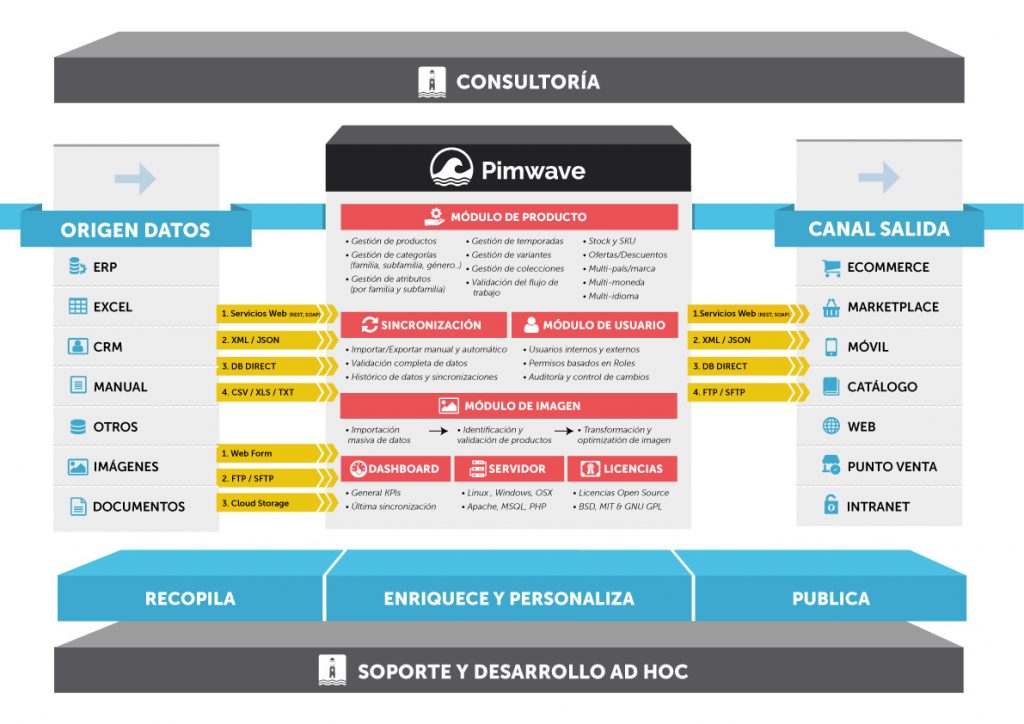The model of product distribution, known as retail, is undergoing irreversible changes worldwide. In recent years, we have witnessed one of the most significant business transformations of the last decades, commonly referred to as “digital transformation”.
In the field of retail, regardless of the specific sector, digital transformation extends beyond merely digitalizing or automating business processes to adapt them to new technological tools. Several elements now are part of the business reality, including the exponential growth of e-commerce, the emergence of major players like Amazon into our lives, the continuous expansion of specialized marketplaces, and the impact of globalization.
With these factors in mind, it becomes evident that the management model of retail companies, primarily focused on marketing products, has evolved. The sales and marketing management strategy must now encompass new “digital” sales channels that coexist with traditional channels. This concept leads us to the industry buzzword known as “omnichannel”, which essentially emphasizes the harmonious coexistence of digital channels and traditional distribution channels, such as physical stores, points of sale, and networks of agents.
Therefore, the same product can potentially be marketed through different channels simultaneously, whether digital or not. To do so effectively and efficiently, it must be adapted to the unique characteristics, particularities, and restrictions of each channel.
This is where a key element that is revolutionizing product management, as well as commercial and marketing practices, comes into play. It is known as PIM, which stands for Product Information Management. In simple terms, a Pim solution is an application that centralizes all the information related to a product: descriptions, attributes, characteristics, categorizations, etc., as well as unstructured information that is part of a product such as images, videos, documents, etc.

Description of a PIM solution
To provide a simple explanation of how a PIM solution is organized, we can divide it into three main sectors or blocks:
Management of inbound channels
In this phase, the focus is on collecting existing information about our products from various sources such as ERP systems, databases, marketing applications, etc.
Information management and enrichment
This section is dedicated to enriching our product information. It involves tasks like adding descriptions, creating attributes, categorizing, sorting, prioritizing, adding languages, managing multiple currencies, setting different prices, and more. Additionally, the product life cycle is controlled through workflows, ensuring the quality and integrity of the information.
Management of output channels
The number of outbound channels is currently growing considerably. In addition to traditional distribution channels like physical stores and agent networks, there are also various digital channels, such as the company’s own e-commerce platform, as well as integration with popular marketplaces like Amazon, eBay, Google, Privalia, Zalando, Pixmania, etc.
With this functionality, you can customize and adapt the information of our products to the characteristics of each output channel in an automated way. The product manager only needs to ensure that all the product information is available in the PIM tool, including descriptions, attributes, categorizations, images, videos, PDFs, etc. From this point on, the PIM platform will be responsible for supplying this information to each of the output channels, adjusting to the specific needs and requirements of each of these channels.
Below, we provide some examples of how this key functionality can be adapted to output channels: for instance, in an e-commerce setting, we must provide product information in different languages, use images of varying resolutions depending on the output channel, adjust product categorization for different marketplaces, fill in specific data for each marketplace, display prices in different currencies based on the country of sale, and have different prices for B2B and B2C sales, etc.
In summary, a PIM solution enables efficient management of all product-related information and automates output channels effortlessly. The focus should be on creating the best possible content for our products rather than repeatedly supplying information to each channel manually.
At Mediterranean Consulting, we understand these requirements, which is why we have created Pimwave, an open-source solution that fulfills all the necessary functions of a PIM ecosystem, as described earlier in this article. What sets us apart is our commitment to customization. Each company manages its products uniquely, making each product distinct. With Pimwave, we emphasize our ability to build “your customized PIM” – ensuring that Pimwave becomes “your PIM solution”.

Creating Pimwave has meant for us to explore new paths, developing a distinctive PIM platform with a unique approach, providing our clients with an innovative solution. As Albert Einstein said, “If you are looking for different results, don’t always do the same thing”, or as Graham Bell also expressed, “Never walk the beaten path, for it will only lead you where others have gone”. We are committed to staying true to these principles.
Author: Francesc Xavier Berjano
More information about Pimwave: https://www.pimwave.com
Mediterranean Consulting
Tel: 935 371 222















